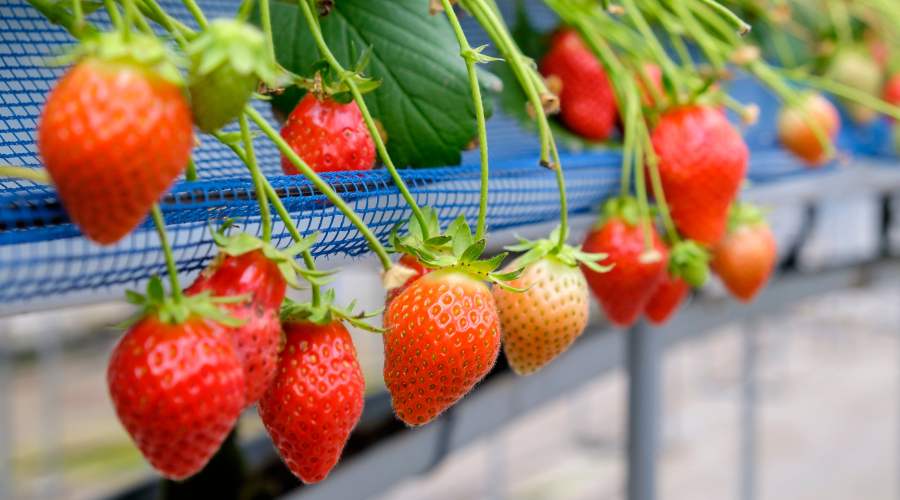Strawberries are beloved by millions worldwide, not only for their delicious taste but also for their numerous health benefits.
Rich in vitamins, antioxidants, and minerals, strawberries play a vital role in maintaining a healthy diet.
As a result, strawberry farming has become a lucrative venture for many aspiring farmers.
This blog post aims to provide a comprehensive, step-by-step guide for starting a successful strawberry farm.
Choosing the Right Location
Selecting the ideal location for your strawberry farm is paramount to its success. Consider the following factors when choosing a location:
- Climate and weather conditions: Strawberries thrive in temperate climates with moderate temperatures and ample sunlight. Extreme heat or cold can adversely affect the crop. Ensure that the chosen location experiences adequate rainfall or has access to water resources for irrigation.
- Soil type and fertility: Strawberries prefer well-drained, sandy loam soil with a pH level between 5.5 and 6.5. Proper drainage is crucial to prevent root rot and other diseases. Conduct a soil test to determine the soil’s pH and nutrient levels, and make adjustments accordingly.
- Access to water resources: A consistent water supply is vital for growing healthy strawberries. Ensure your farm is close to a reliable water source, such as a well or pond, to meet the plants’ irrigation needs.
Selecting the Right Strawberry Variety
There are several popular strawberry varieties, each with unique characteristics:
- June-bearing: These strawberries produce a single, large crop in late spring to early summer. Examples include ‘Allstar,’ ‘Chandler,’ and ‘Honeoye.’
- Everbearing: These varieties produce two to three smaller crops throughout the growing season. ‘Albion,’ ‘Ozark Beauty,’ and ‘Quinault’ are popular everbearing varieties.
- Day-neutral: Day-neutral strawberries are not affected by day length and will produce fruit throughout the growing season, provided the temperature remains between 35-85°F. Examples include ‘Seascape,’ ‘Tribute,’ and ‘Tristar.’
Consider the following factors when choosing a strawberry variety:
- Market demand: Research local market preferences to identify the most sought-after varieties.
- Disease resistance: Opt for varieties with a high resistance to diseases common in your region.
- Climate suitability: Select varieties that are well-suited to your area’s climate conditions.
- Purchase certified disease-free plants from a reputable nursery to ensure a healthy start for your farm.
Preparing the Land for Planting
Soil preparation is crucial for establishing a successful strawberry farm:
- Tilling: Till the soil to a depth of 8-12 inches to improve aeration and drainage.
- Adding organic matter: Incorporate compost or well-rotted manure into the soil to enhance fertility and soil structure.
- Soil pH adjustment: If the soil test indicates an unsuitable pH level, amend the soil with lime (to raise pH) or sulfur (to lower pH).
Once the soil is prepared, plan the layout of your farm:
- Row spacing: Allow 36-48 inches between rows to facilitate airflow and sunlight penetration.
- Plant spacing: Space plants 12-18 inches apart within rows, allowing room for growth and easy access for harvesting.
- Irrigation system installation: Install a drip irrigation system to provide consistent, efficient water delivery.
Planting and Growing Strawberries
Follow these guidelines to ensure healthy, productive strawberry plants:
- Proper planting technique: Plant the strawberries at the correct depth, with the crown (where the stem meets the roots) level with the soil surface. Burying the crown may cause rot, while planting too shallow can lead to desiccation.
- Irrigation and watering requirements: Strawberries require consistent moisture, especially during the fruiting stage. Use drip irrigation to deliver water directly to the plants’ root zone, preventing overwatering and reducing disease risk. Water early in the day to allow the foliage to dry before nighttime, reducing the risk of fungal infections.
- Fertilization and nutrient management: Apply a balanced, slow-release fertilizer at planting time, and supplement with additional nitrogen applications throughout the growing season. Base fertilizer rates on soil test results to avoid over-fertilization, which can lead to excessive vegetative growth and reduced fruit production.
- Pest and disease control: Regularly inspect your plants for signs of pests and diseases. Implement an integrated pest management (IPM) approach, using cultural, mechanical, and biological controls before resorting to chemical treatments. Some common strawberry pests include slugs, spider mites, and aphids, while diseases include powdery mildew, gray mold, and verticillium wilt.
- Weed management: Weeds compete with strawberries for nutrients, water, and sunlight. Use mulch, such as straw or black plastic, to suppress weeds and maintain soil moisture. Hand-pull weeds close to the plants to avoid damaging the root system.
- Pruning and thinning: Remove damaged or diseased leaves and runners (horizontal stems) to encourage air circulation and reduce disease risk. Limit each plant to 4-5 healthy runners to promote strong, productive plants.
Harvesting and Post-Harvest Management
- Identifying the right time to harvest: Harvest strawberries when they are fully ripened and have reached a uniform, bright red color. The berries should be firm but not hard.
- Proper harvesting techniques: Gently twist or snip the berries from the plant, leaving the green calyx (cap) attached to the fruit. Handle the fruit carefully to prevent bruising or damage.
- Post-harvest handling and storage: Store harvested strawberries in shallow containers and refrigerate them as soon as possible. Maintain a temperature of 32-34°F and a relative humidity of 90-95% to prolong shelf life.
- Marketing and selling your strawberries: Develop a marketing strategy that includes selling your strawberries at farmers’ markets, local grocery stores, restaurants, or even offering a pick-your-own experience. Consider value-added products like jams, jellies, or preserves to diversify your revenue stream.
Scaling Up Your Strawberry Farm
- Adding new varieties or expanding your farm: As your strawberry farm grows, consider planting additional varieties or increasing your farm’s acreage to meet market demand and maximize profit.
- Investing in advanced farming techniques and equipment: Utilize modern farming practices like plasticulture, vertical farming, or hydroponics to increase yield and efficiency. Invest in equipment that can streamline planting, harvesting, and post-harvest processes.
- Strategies for increasing yield and profitability: Implement crop rotation, cover cropping, and other sustainable farming practices to maintain soil health and fertility. Continuously monitor and adjust your farm’s management practices to optimize yield and profitability.
Conclusion
Starting a successful strawberry farm requires careful planning, attention to detail, and dedication.








